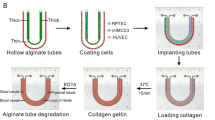Summary
To explore a new way of constructing bioartificial renal tubule assist device (RAD) in vitro and its function of transporting sodium (Na+) and glucose and to evaluate the application of atomic force microscope in the RAD construction, rat renal tubular epithelial cell line NRK-52E was cultured in vitro, seeded onto the outer surfaces of hollow fibers in a bioreactor, and then cultured for two weeks to construct RAD. Bioreactor hollow fibers without NRK-52E cells were used as control. The morphologies of attached cells were observed with scanning electron microscope, and the junctions of cells and polysulfone membrane were observed with atomic force microscope. Transportation of Na+ and glucose was measured. Oubaine and phlorizin were used to inhibit the transporting property. The results showed that NRK-52E cells and polysulfone membrane were closely linked, as observed under atomic force microscope. After exposure to oubaine and phlorizin, transporting rates of Na+ and glucose were decreased significantly in the RAD group as compared with that in the control group (P<0.01). Furthermore, when the inhibitors were removed, transportation of Na+ and glucose was restored. It is concluded that a new RAD was constructed successfully in vitro, and it is able to selectively transport Na+ and glucose.
Similar content being viewed by others
References
Lameire N, Van Biesen W, Vanholder R. Acute renal failure. Lancet, 2005,365:417–430
Fissell WH, Humes HD, Fleischman AJ, et al. Dialysis and nanotechnology: now, 10 years, or never? Blood Purif, 2007,25(1):12–17
Humes HD, Mackay SM, Funke AJ, et al. The bioartifiacial renal tubule assist device to enhance CRRT in acute renal failure. Ren Fail, 1996,18(4):405–408
Humes HD, Mackay SM, Funke AJ, et al. Tissue engineering of a bioartificial renal tubule assist device: in vitro transport and metabolic characteristics. Kidney Int, 1999, 55(6):2502–2514
Tiranathanagul K, Dhawan V, Lytle IF, et al. Tissue engineering of an implantable bioartificial hemofilter. ASAIO J, 2007,53(2):176–186
Tumlin J, Wali R, Williams W, et al. Efficacy and safety of renal tubule cell therapy for acute renal failure. J Am Soc Nephrol, 2008,19:1034–1040
Issa N, Messer J, Paganini EP. Renal assist device and treatment of sepsis-induced acute kidney injury in intensive care units. Contrib Nephrol, 2007,156:419–427
Dong XG, Chen JH, He Q, et al. Retrospect and prospect of ten years’ research in bioartificial renal tubule assist device. Int J Transplant Hemopurif (Chinese), 2008,6(2): 41–42
Dong XG, Chen JH, He Q, et al. Determination of the cell viability in bioartificial renal tubule assist device by MTT assay. Bull Sci Technol (Chinese), 2009,25(5) in press
Dong XG, Chen JH, He Q, et al. Evaluation on methods for the morphological observation of polysulfone hollow fiber membrane in hemofilter. Bull Sci Technol (Chinese), 2008, 24(5):636–640
Fissell WH, Fleischman AJ, Humes HD, et al. Development of continuous implantable renal replacement: past and future. Transl Res, 2007,150(6):327–336
Humes HD, Fissell WH, Tiranathanagul K. The future of hemodialysis membranes. Kidney Int, 2006,69(7): 1115–1119
Tiranathanagul K, Eiam OS, Humes HD, et al. The future of renal support high-flux dialysis to bioartificial kidneys. Crit Care Clin, 2005,21(2):379–394
Fissell WH, Manley S, Westover AJ, et al. Differentiated growth of human renal tubule cells on thin film and nanostructured materials. ASAIO J, 2006,52(3):221–227
Ding F, Humes HD. The bioartificial kidney and bioengineered membranes in acute kidney injury. Nephron Exp Nephrol, 2008,109(4):e118–e122
Mao H, Wang XY, Ying X, et al. Effect of continuous bioartificial kidney therapy on porcine multiple organ dysfunction syndrome with acute renal failure. ASAIO J, 2007,53(3):329–334
Saito A, Aung T, Sekiguchi K, et al. Present status and perspectives of bioartificial kidneys. J Artif Organs, 2006,9(3):130–135
Saito A, Aung T, Sekiguchi K, et al. Present status and perspective of the development of a bioartificial kidney for chronic renal failure patients. Ther Apher Dial, 2006, 10(4):342–347
Fissell WH, Lou L, Abrishami S. Bioartificial kidney ameliorates gram-negative bacteria induced septic shock in uremic animals. J Am Soc Nephrol, 2003,14(2): 454–461
Humes HD, Weitzel WF, Bartlett RH, et al. Initial clinical results of the bioartificial kidney containing human cells in ICU patients with acute renal failure. Kidney Int, 2004, 66(4):1578–1588
Humes HD, Weitzel WF, Fissell WH, et al. Renal cell therapy in the treatment of patients with acute and chronic renal failure. Blood Purif, 2004,22(1):60–72
Quan A, Quigley R. Renal replacement therapy and acute renal failure. Curr Opin Pediatr, 2005,17(2):205–209
Hodges SJ, Atala A. Initial clinical results of the bioartificial kidney containing human cells in ICU patients with acute renal failure. Curr Urol Rep, 2006,7(1):41–42
Fissell WH, Manley S, Westover A, et al. Differentiated growth of human renal tubule cells on thin-film and nanostructured materials. ASAIO J, 2006,52(3):221–227
Ueda H, Watanabe J, Konno T, et al. Asymmetrically functional surface properties on biocompatible phospholipid polymer membrane for bioartificial kidney. J Biomed Mater Res A, 2006,77(1):19–27
Author information
Authors and Affiliations
Rights and permissions
About this article
Cite this article
Dong, X., Chen, J., He, Q. et al. Construction of bioartificial renal tubule assist device In Vitro and its function of transporting sodium and glucose. J. Huazhong Univ. Sci. Technol. [Med. Sci.] 29, 517–521 (2009). https://doi.org/10.1007/s11596-009-0425-5
Received:
Published:
Issue Date:
DOI: https://doi.org/10.1007/s11596-009-0425-5




